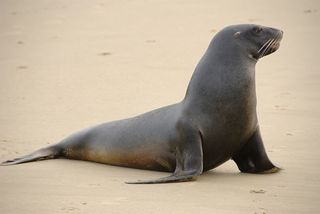
New Zealand sea lion
Order : Carnivora
Family : Otariidae
Species : Phocarctos hookeri
The Hooker's sea lion, hooker's sealion, new zealand sea lion, new zealand sealion is listed as Vulnerable (VU), considered to be facing a high risk of extinction in the wild, on the IUCN Red List of Threatened Species
Namings for the New Zealand sea lion
A young / baby of a New Zealand sea lion is called a 'pup or beach weaner'. The females are called 'cow' and males 'bull'. A New Zealand sea lion group is called a 'pod, colony, crash, flock, harem, bob, herd, rookery, team or hurd'.Countries
New ZealandNew Zealand sea lion habitats
Estuaries, Marine Intertidal, Marine Neritic, Rocky Shoreline, Sandy Shoreline and / or Beaches, Sand Bars, Spits and EtcSome facts about the
New Zealand sea lion
Adult weight : 187.58 kg (412.676 lbs)
Male maturity : 2191 days
Gestation : 365 days
Weaning : 213 days
Litter size : 1
Litters per year : 1
Weight at birth : 7 kg (15.4 lbs)
Facts about the New Zealand sea lion
World Range & HabitatThe Hooker's sea lion, Phocarctos hookeri, is one of the rarest and most endangered sea lions.
The New Zealand sea lion (Phocarctos hookeri) is listed as Vulnerable in the 2003 IUCN (World Conservation Union) Red List of Globally Threatened Species.
The New Zealand sea lion (Phocarctos hookeri) is one of the world's rarest eared seals and is endemic to New Zealand's sub-Antarctic waters.
The New Zealand Sea Lion The New Zealand sea lion or Hooker’s sea lion (Phocarctos hookeri) is a protected marine mammal.
Hooker's sea lion (Phocarctos hookeri) is endemic to New Zealand and can be found mainly on the Subantarctic Islands.
The Hookerâs sea lion (Phocarctos hookeri) is classified as a threatened species and is one of the rarest species of sea lion in the world (Wilkinson, Burgess & Cawthorn 2001).
The New Zealand sea lion is found only in New Zealand waters and is one of the world's rarest seal species. (Full text)
The New Zealand sea lion is found only in New Zealand waters and
The New Zealand sea lion is recognised as a threatened species by the IUCN- World Conservation Union list of threatened species. (Full text)
The New Zealand sea lion is also commonly called Hooker's sea lion.
The New Zealand sea lion is one of the world's most threatened sea lions. (Full text)
The New Zealand Sea Lion is categorised as Vulnerable on the 1994 IUCN Red List of Threatened Animals.
New Zealand sea lions are opportunistic feeders and the majority of their diet consists of cephalopods (such as squid and octopus), crabs, crayfish and many species of fish.
Behavior: New Zealand sea lions are generally calm creatures.
New Zealand sea lions are among the rarest in the world. (Full text)
Hooker’s sea lions, also known as New Zealand sea lions, are one of only 5 species of sea lions in the world, the others being the Australian sea lion, the South American sea lion, the California sea lion and Steller sea lion. (Full text)
The New Zealand Sea Lions are also known as Hooker's Sea Lions.
New Zealand sea lions are the deepest diving otariid seals (eared seals), with animals repeatedly diving to depths in excess of 500 metres.
New Zealand sea lions are currently recolonising the New Zealand mainland following a period of historical exploitation.
New Zealand sea lions are generalist feeders utilising a wide variety of prey items, with fish comprising the most common taxa (59%) numerically and both cephalopods (21%) and crustacea (15%) forming lesser, but still important, parts of the diet. (Full text)
New Zealand sea lions are protected under the Marine Mammals Protection Act. (Full text)
New Zealand sea lions are the country’s only endemic pinniped (wing-footed marine mammal), and they once occupied most of the country’s (Full text)
More animals beginning with N
